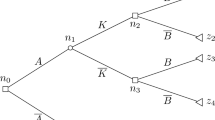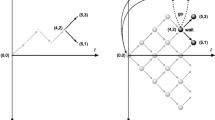Abstract
Based upon the Decision Field Theory (Busemeyer and Townsend 1993), we tested a model of dynamic reasoning to predict the effect of time pressure on analytical and experiential processing during decision-making. Forty-six participants were required to make investment decisions under four levels of time pressure. In each decision, participants were presented with experiential cues which were either congruent or incongruent with the analytical information. The congruent/incongruent conditions allowed us to examine how many decisions were based upon the experiential versus the analytical information, and to see if this was affected by the varying degrees of time pressure. As expected, the overall accuracy was reduced with greater time pressure and accuracy was higher when the experiential and analytical cues were congruent than when they were incongruent. Of great interest was the data showing that under high time pressure participants used more experiential cues than at other time pressures. We suggest that the dynamic reasoning paradigm has some future potential for predicting the effects of experiential biases in general, and specifically under time pressure.
Similar content being viewed by others
Abbreviations
- DFT:
-
Decision field theory
- RAT:
-
Rational model
- TTB:
-
Take-the-best model
- EXP:
-
Experiential system output
References
Bechara A., Damasio H., Tranel D., Damasio A. R. (1997) Deciding advantageously before knowing the advantageous strategy. Science 275: 1293–1295
Ben-Zur H., Breznitz S. J. (1981) The effects of time pressure on risky choice behaviour. Acta Psychologica 81: 211–241
Berthoz A. (2006) Emotion and reason: The cognitive neuroscience of decision-making. Oxford University Press, Oxford
Damasio A. R. (1994) Descartes’ error: Emotion reason, and the human brain. Putnam, New York
Dror I. E., Busemeyer J. R., Basola B. (1999) Decision making under time pressure: An independent test of sequential sampling models. Memory and Cognition 27(4): 713–725
Evans J. St. B. T., Barston J. L., Pollard P. (1983) On the conflict between logic and belief in syllogistic reasoning. Memory and Cognition 11: 295–306
Finucane M.L., Peters E., Slovic P. (2003) Judgement and decision-making: The dance of affect and reason. In: Schneider S.L., Shanteau J. (eds) Emerging perspectives on judgement and decision research. Cambridge University Press, Cambridge, UK, pp 327–364
Freeman W., Watts J. W. (1942) Psychosurgery intelligence emotion and social behavior following prefrontal lobotomy for mental disorders. Charles C Thomas, Springfield, IL
Freund T., Kruglanski A. W., Shpitzajzen A. (1985) The freezing and unfreezing of impressional primacy: Effects of the need for structure and the fear of invalidity. Personality and Social Psychology Bulletin 11: 479–487
Gigerenzer G., Todd P. M. (1999) Simple heuristics that make us smart. Oxford University Press, New York
Gonzales C., Dana J., Koshino H., Just M. (2005) The framing effect and risky decisions: Examining cognitive functions with fMRI. Journal of Economic Psychology 26: 1–20
Hogarth R. M. (2001) Educating intuition. University of Chicago Press, Chicago
Kahneman D., Frederick S. (2002) Representativeness revisited: Attribute substitution in intuitive judgement. In: Gilovich Griffin D., Kahneman (eds) Heuristics and biases: The psychology of intuitive judgement. Cambridge University Press, Cambridge, pp 49–81
Kruglanski A. W., Freund T. (1983) The freezing and unfreezing of lay-inferences: Effects on impressional primacy, ethnic stereotyping, and numerical anchoring. Journal of Experimental Social Psychology 19: 448–468
Kunda Z. (1990) The case for motivated reasoning. Psychological Bulletin 108: 480–498
Lee M. D., Cummins T. D. R. (2004) Evidence accumulation in decision making: Unifying the “take the best” and the “rational” models. Psychonomic Bulletin & Review 11(2): 343–352
Loewenstein G. F., Weber E. U., Hsee C. K., Welch E. S. (2001) Risk as feelings. Psychological Bulletin 127: 267–286
Payne J. W., Bettman J. R. (2004) The information-processing approach to decision making. In: Koehler D. J., Harvey N. (eds) Blackwell Handbook of Judgement and Decision Making.. Blackwell Publishing, London, pp 110–132
Payne J.W., Bettman J.R., Johnson E.J. (1993) The adaptive decision maker. Cambridge University Press, Cambridge
Rolls E. T. (1999) The brain and emotion. Oxford University Press, New York
Sloman S. A. (1996) The empirical case for two systems of reasoning. Psychological Bulletin 119: 3–22
Svenson O., Edland A. (1987) Change in preferences under time pressure: Choices and judgements. Scandinavian Journal of Psychology 29(4): 322–330
Wallsten T. S. (1993) The pressure and payoff effects on multidimensional probabilistic inference. In: Svenson O., Maule A. J. (eds) Time pressure and stress in human judgement and decision making.. Plenum, New York, pp 167–179
Wilson T. D., Schooler J. W. (1991) Thinking too much: Introspection can reduce the quality of preferences and decisions. Journal of Personality and Social Psychology 60(2): 181–192
Author information
Authors and Affiliations
Corresponding author
Rights and permissions
About this article
Cite this article
Fraser-Mackenzie, P.A.F., Dror, I.E. Dynamic reasoning and time pressure: Transition from analytical operations to experiential responses. Theory Decis 71, 211–225 (2011). https://doi.org/10.1007/s11238-009-9181-z
Published:
Issue Date:
DOI: https://doi.org/10.1007/s11238-009-9181-z




